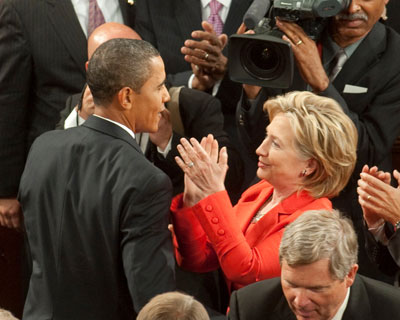It is no secret that when it comes to the use of power, the Obama Administration vastly prefers “soft” power to the military variety. In a recent article in Politico, Michael Clauser, executive vice president of the Society of National Security Professionals, writes that proposed cuts to the Pentagon budget will “reignite a key Washington budget debate: the proportionality of military spending relative to nonmilitary international affairs.”
As the Pentagon still spends almost 20 times more on defense than the State Department does on other nonmilitary-related international affairs activities (for very good reasons), this is undoubtedly true. No love has been lost over the years between the departments of Defense and State.
For its part, the Pentagon tends to look upon State as an ineffectual bureaucratic swamp where endless talk takes the place of action, while State tends to look at Defense as primitive and overmilitarized in its view of the world and suspects that the Pentagon secretly wants to run U.S. foreign policy. Yet, writes Clauser, “of all national budget debates, the fratricide for funds between State and Defense is most puzzling as their roles are so intrinsically complimentary.” National defense and the diplomatic tools of American leadership in the world should be mutually reinforcing.
In reality, however, the Obama Administration had made up its mind about the Defense vs. State debate early in the Obama presidency. In December 2010 the State Department and U.S. Agency for International Development (USAID) published a “Quadrennial Diplomacy and Development Review (QDDR)” intended to serve as a roadmap to implement the Administration’s “Presidential Policy Directive (PPD) on Global Development.” The Obama Administration’s vaunted “smart power” approach to development promised to change the ways the government does business, but in practice, the QDDR mainly proposed expanding the bureaucracy of State and USAID and supporting a host of existing and new development assistance programs—despite empirical evidence that many of them will not work.
Furthermore, as far back as 2007, Secretary of Defense Robert Gates expressed the desire to hand off the Pentagon’s communication and reconstruction capabilities to civilian agencies, famously questioning how “one man in a cave managed to out-communicate the world’s greatest communications society?” (That would be the late and unlamented Osama bin Laden). Gates proposed to rebalance budget priorities toward the State Department and advocated increasing its funding significantly. He got what he wished for. Since then, the vultures circling the Department of Defense have come home to roost.
The Defense budget will decline by 5 percent according to the President’s fiscal year 2012 budget, to $702.8 billion, setting the department on a trajectory toward a disastrous decline in capabilities. Meanwhile, the State Department is enjoying golden days with its biggest bump in recorded history—increasing its funding by more than 25 percent since 2007 to $47 billion, according to the International Affairs budget proposal for FY 2012.
At a time when Defense is under pressure to make crippling cuts, State Department and USAID programs should not be exempt from scrutiny. American international leadership, after all, is intrinsically tied to its global deployments, which provide peace, stability, open sea lanes, and disaster relief as well as military action when required in the national interest. Though they are key elements of foreign policy, American diplomacy and foreign aid can hardly be said to have produced the global preeminence enjoyed by the United States since World War II. State and Defense should work together—but “rebalancing” that robs Peter to pay Paul will not serve the nation well.
Source material can be found at this site.










